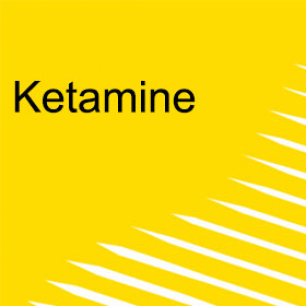Ketamine
special K, K, ket, kitkat, super k or horse trank
What is ketamine?
Ketamine is a dissociative general anaesthetic, classed as a hallucinogen when used illegally as a recreational drug.
Doctors and vets use ketamine because it produces analgesia (pain relief) and amnesia. It is also sometimes described as a horse tranquiliser due to its use in veterinary medicine.
When sold illegally, ketamine usually comes as a white crystalline powder, but it can also be made into tablets or dissolved in a liquid (ADF, 2019).
Ketamine is usually snorted through a small glass nasal inhaler (a ‘bumper’), although it can also be swallowed, smoked or injected.
What are the effects?
The effects of ketamine may be experienced within 30 seconds if injected, five to ten minutes if snorted, and up to 20 minutes if swallowed. The effects of ketamine can last for approximately 45 to 90 minutes (ADF, 2019).
Short-term effects:
- A sense of euphoria and well-being
- Hallucinations
- Increased libido
- Dissociation
- A sense of floating
- Drowsiness
- Nausea and vomiting
Long-term effects:
- Headaches
- Flashbacks
- Poor sense of smell (from snorting)
- Mood and personality changes, depression
- Poor memory, thinking and concentration
- Ketamine bladder syndrome – a painful condition which can cause ulceration of the bladder
- Abdominal pain
- Needing to use more to get the same effect (tolerance)
- Dependence (ADF, 2019)
Coming down
The day following ketamine use, a person may experience:
- Memory loss impaired judgement
- Disorientation
- Clumsiness
- Aches and pains
- Depression (ADF, 2019)
What are the risks?
Mixing ketamine with other drugs
The effects of using ketamine with other drugs, including over the counter prescription medication, is highly unpredictable.
The use of ketamine with psychostimulants (amphetamine, ecstasy and amphetamine) can put enormous strain on the heart, increasing the risk of a cardiovascular event (ADF, 2019).
The toxic effect of ketamine use is a psychosis-like state, sometimes referred to as a ‘k hole’.
Toxicity and overdose
There have been deaths associated with ketamine overdose, but they have been predominantly attributed to polydrug use. Signs of overdose include:
- Fast heart rate (tachycardia)
- Hyperthermia
- Nausea
- Blurred vision
- Tremors
- Confusion
- Delusions
- Anxiety
- Severe agitation (Darke, Lappin & Farrell, 2019)
Dependence and withdrawal
There is an established ketamine dependence and withdrawal syndrome. Withdrawal symptoms usually last for four to six days (Darke, Lappin & Farrell, 2019). They include:
- Anxiety
- Sweating
- Heart palpitations (Darke, Lappin & Farrell, 2019)
- Cravings for ketamine
- No appetite
- Tiredness
- Restlessness, tremors (ADF, 2019)
Mental health
Hallucinogens have the potential to give rise to psychotic symptoms, sometimes known as a ‘bad trip’. It’s been found that following a single dose healthy volunteers can experience both positive and negative psychotic symptoms.
Daily users of ketamine experience psychotic-related symptoms, especially among people who have a history of mental illness:
- Delusions
- Dissociation
- Anxiety
- Panic attacks
- Psychotic symptoms can be triggered in some people (e.g. those with schizophrenia) (Darke, Lappin & Farrell, 2019)
How many people use ketamine?
According to the Australian Institute of Health and Welfare, use of ketamine in the previous 12 months increased from 0.4 percent in 2016 to 0.9 percent in 2019, mainly due to recent use doubling among people in their 20s over this period (1.2 percent to 3.9 percent) (AIHW, 2020).
Treatment
There is a lack of research on the treatment of hallucinogen dependence. Some treatments for other drugs like psychostimulants may be appropriate. The effectiveness for cognitive behavioural therapy (CBT) for the treatment of psychostimulant and cannabis dependence suggests that it might be useful for ketamine dependence (Darke, Lappin & Farrell, 2019).
Emergency info
If you, or someone around you, is experiencing undesired or distressing psychological or physical symptoms from the intake of alcohol or other drugs please seek immediate medical attention.
If you need urgent help from ambulance services call Triple Zero (000). If a person has been mixing drugs with alcohol or other drugs, tell the paramedic exactly what has been taken.
Services
For free and confidential advice about alcohol and other drugs, call the National Alcohol and Other Drug hotline on 1800 250 015.
The hotline will automatically direct you to the Alcohol and Drug Information Service in your state or territory.
More resources
The Illicit Drug Reporting System is an Australian monitoring system that identifies emerging trends of local and national interest in illicit drug markets.
The Ecstasy and Related Drugs Reporting System is an Australian monitoring system for ecstasy and related drugs that identifies emerging trends of local and national interest.
The Clinician’s Guide to Illicit Drugs and Health examines the health effects of each of the major illicit drugs.
The Australian Institute of Health and Welfare collects information on alcohol and tobacco consumption, and illicit drug use among the general population in Australia.
The Australian Bureau of Statistics is Australia’s national statistical agency, providing official statistics on a range of economic, social, population and environmental matters of importance to Australia.
Sources
Alcohol and Drug Foundation (2019). Ketamine. Retrieved from https://adf.org.au/drug-facts/ketamine/
Australian Institute of Health and Welfare (2020). Australian National Drug Strategy Household Survey 2019. Retrieved from https://www.aihw.gov.au/reports/illicit-use-of-drugs/national-drug-strategy-household-survey-2019/contents/table-of-contents
Darke, S., Lappin, J., & Farrell, M. (2019). The Clinician’s Guide to Illicit Drugs and Health, Great Britain: Silverback Publishing


